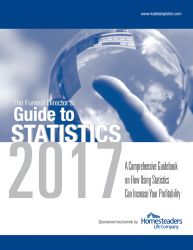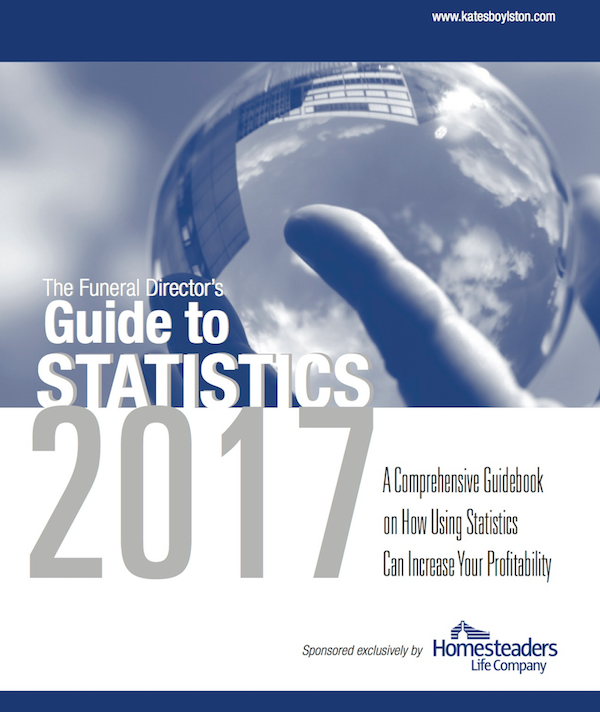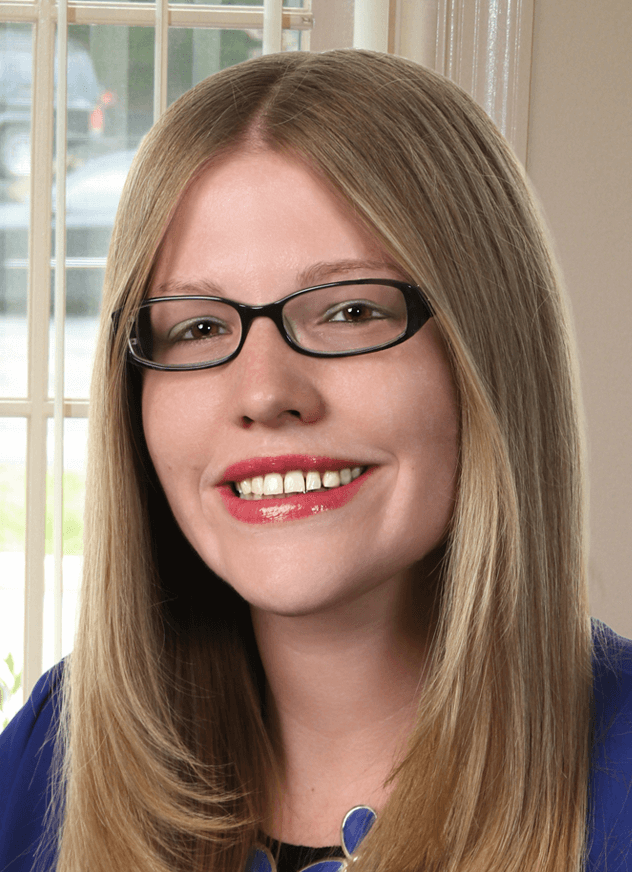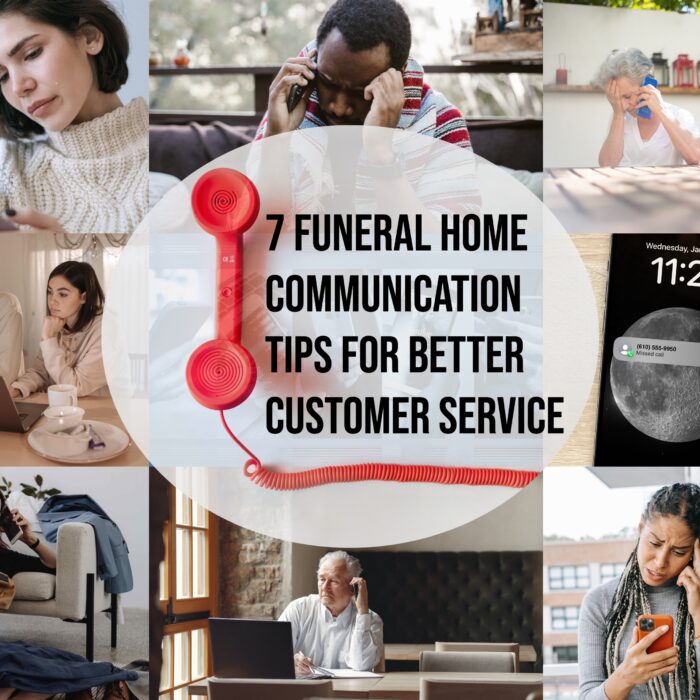Feb 20, 2018
This article was originally published in Kates Boylston Publications Funeral Director’s Guide to Statistics (2017 issue) by our Staff Writer, Jessica Farren (Fowler). This latest edition features the most up-to-date statistical information in the industry, and provides you with tools and knowledge to better understand buying trends, what services families want most and more. Click here to learn more or to order your copy of the Funeral Director’s Guide to Statistics.
There are two fundamental questions every funeral home’s
marketing strategy should address. The first, and most obvious is
how do we get the phone to ring? Or, to
be more specific, how do we persuade families in our area to contact our
funeral home in their time of need? The second question, although equally
important, is often overlooked when funeral homes analyze their marketing
efforts.
How do we ensure that every
call, without exception, is answered promptly and handled properly?
With so much emphasis placed on attracting
interest, funeral professionals must be careful not to forget how communication
can impact their funeral home’s reputation and growth.
This survey
examines the synergistic relationship between funeral home marketing and
communication. Overall, more than 1,700 funeral professionals responded to the
survey.
Participants were asked to
answer questions about the strategies they have used to grow their funeral
home’s market share, communication challenges they have experienced and mobile
technology preferences. The survey also studies the impact of shopper
calls on funeral home marketing and communication.
The survey was
conducted by ASD – Answering Service for Directors, the leading funeral home
answering service, and was sent by means of a questionnaire using the internet
survey tool Survey Monkey. In an effort to construct a thorough analysis of the
marketing and communication behaviors of funeral professionals, ASD polled both
its current client base as well as funeral professionals who do not use the
company’s services.
About
Survey Participants
Current Position
The survey drew responses from 1,791 funeral professionals: About
37 percent (659) were full-time licensed funeral directors, 18 percent (321)
were sole owners, 16 percent (282) were co-owners, 11 percent (211) were
managers, 3 percent (57) were apprentices, 3 percent (52) were part-time
licensed funeral directors, 2 percent (45) were office receptionists, 2 percent
(28) were family counselors and 2 percent (27) were funeral attendants. About 6
percent (109) selected ‘other’ and listed a different position such as
crematory operator, embalmer or event director.
Location
The survey was sent out to funeral homes located in all 50
states. About 46 percent (817) of the funeral
professionals polled serve families in a suburban area, 33 percent (595) serve
families in a rural area, and 21 percent (379) serve families in an urban area.
First Calls Handled Per Year
About 75 percent of funeral professionals surveyed handle
more than 100 cases per year. More than a third handle over 300 cases a year.
Below is a breakdown of this data.
|
First Calls Handled/ |
% of Respondents |
Number of |
|
0-50 |
7 percent |
126 |
|
50-100 |
17 percent |
302 |
|
100-299 |
44 percent |
786 |
|
300-499 |
16 percent |
291 |
|
More than 500 |
16 percent |
286 |
Marketing and Growth Trends
Cremation Rate
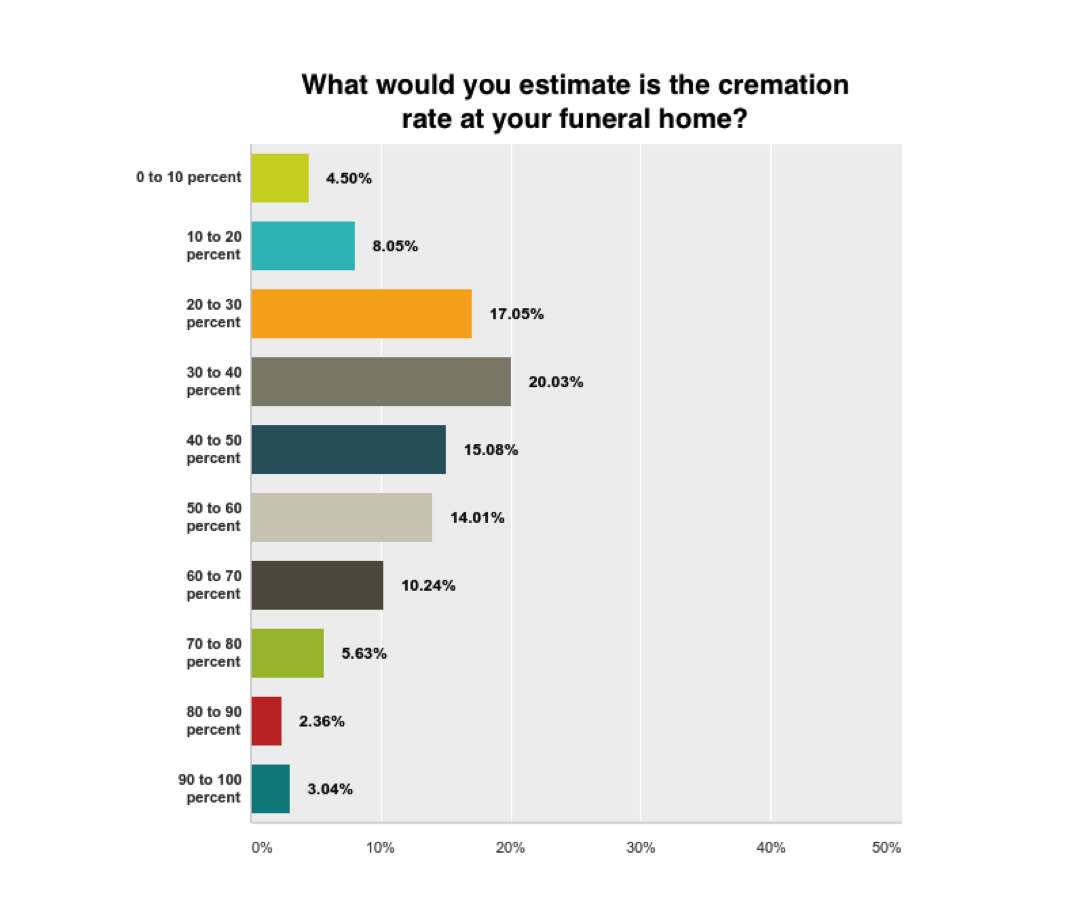
Slightly more than half of the funeral professionals polled
(898) have a cremation rate over 40 percent. Below is a full breakdown of this
data.
Market Share Growth
Participants were asked how much attention is given to
growing their funeral home’s market share. Nearly half of the respondents (41 percent)
answered that a ‘tremendous amount’ or ‘a lot’ of time was given to growing the
funeral home business. A nearly equal number (39 percent) of participants
selected ‘a reasonable amount’. About 20 percent answered that very little or
no time at all is spent growing their funeral home’s market share. These
results suggest that while most funeral professionals want to achieve a
competitive advantage, a surprisingly high number do not have the time or
resources to focus on growth. It is also possible a portion of the funeral professionals
interviewed may be less focused on increasing their market share because they
feel they have already achieved this objective.
Marketing Methods
The survey asked funeral professionals to indicate what
materials their funeral home uses to market the business and achieve goals. Below
is a breakdown of the most commonly utilized marketing materials listed by
survey participants.
- 60 percent use promotional brochures and pamphlets
- 55 percent send surveys to families served in the past
- 41 percent have a defined business plan
- 38 percent have a defined marketing plan
- 32 percent use website lead conversion tracking
- 21 percent use phone call conversion tracking
- 19 percent send newsletters or bulletins to families served
in the past.
This data reveals how marketing can often take a backseat to
other business matters within a funeral home. While more than half of those
surveyed have implemented at least one type of marketing initiative in the
past, these statistics suggest a lack of consistency and follow through may
hinder results. Less than half of survey respondents utilize a business or
marketing plan when implementing different strategies. These statistics
indicate that many of the marketing efforts used by funeral homes may be
executed without a focus on long-term goals. The old mantra,
‘throw it against the wall and see what
sticks’
seems to be governing these decisions, leading many to adopt a
trial-and-error based approach. Without such a business or marketing plan in
place, funeral directors may begin to see marketing efforts as fruitless
because they have not created metrics for tracking results.
Another example of this lack of focus was revealed by asking
funeral professionals how they market to families they have previously served.
While more than half (55 percent) send out surveys to families they have served
in the past, only 19 percent send newsletters or bulletins. The data reveals a
surprisingly high number of outreach opportunities are being missed by funeral
homes. Newsletters and bulletins allow funeral homes to expand their aftercare
programs and help their community to view them as a resource. While it is
certainly helpful to gather feedback from families, it is just as important, if
not more so, to maintain these relationships and demonstrate your funeral
home’s ongoing support. These two marketing goals should be closely aligned,
yet more than 80 percent of funeral professionals surveyed did not make this
connection.
ASD also asked survey participants if they currently
utilized a marketing company to promote their services. Less than half (48
percent) are currently using a marketing company. This number reveals many of
the funeral homes that have created marketing materials and strategies have
done so with little to no guidance.
Communication Trends and Challenges
Shopper Calls
Participants
were asked what percentage of their funeral home’s new business they estimate
comes from shopper calls. For clarification purposes, the term ‘shopper’ was
defined within the survey as any
person who is contacting a funeral home they have no prior experience with to
gather information on services, options and/or pricing. About 60 percent of
funeral professionals polled attribute between 10 and 40 percent of their new
business to shopper calls. More than a third (36 percent) of respondents
attribute over 20 percent of their new business to shopper calls. Below is a
full breakdown of this data:
|
Percentage of new business obtained through shopper calls |
Percentage of Respondents |
|
Less than 10 percent |
31 percent |
|
10 to 20 percent |
33 percent |
|
20 to 30 percent |
19 percent |
|
30 to 40 percent |
8 percent |
|
More than 40 percent |
9 percent |
Average Duration of
Shopper Calls
How
much time do funeral professionals typically spend answering questions from
shoppers? The majority of survey respondents (38 percent) answered that the
average duration of these calls is 5 to 10 minutes. Only one quarter of
survey respondents spend more than 10 minutes on average when handling shopper
calls. Below is a full breakdown of this data.
|
Shopper Call Duration |
Percentage of Respondents |
|
Less than 2 minutes |
3 percent |
|
2-5 minutes |
34 percent |
|
5-10 minutes |
38 percent |
|
10-15 minutes |
17 percent |
|
15-25 minutes |
6 percent |
|
More than 25 minutes |
2 percent |
Telecommunication Disruption
ASD asked participants what telecommunication problems their
funeral home has experienced in the past 12 months. Below is a breakdown of the
most common disruption issues that affect funeral professionals:
- 19 percent have experienced a power outage
- 13 percent have experienced call forwarding
issues - 12 percent have had miscommunication issues
arise between on-call employees. - 6 percent have had issues with missing urgent
calls - 4 percent have had issues with crossed telephone
lines - 4 percent have experienced ‘Other’ issues
including problems with their phone system or company (36 percent), Internet
issues (26 percent), issues with solicitation calls (20 percent), answering
service issues (13 percent), or cell phone issues (5 percent).
Cellular
service problems were the most common issue reported, which is consistent with
national statistics. According to Pew Research, 72 percent of cell phone owners
in America have experienced dropped calls occasionally, while 32 percent say
they experience this problem on a weekly basis. Mobile reliability statistics
vary greatly by region, with consumers in urban areas experiencing the highest
number of overall network problems (J.D. Power).
The second
most common issue reported was power outages. This is a widespread issue that
has increased in recent years, with the U.S. Department of Energy data showing
that the number of reported power outages in the country rose steadily between
2000 and 2014, with the annual average of outages doubling every five years. In
fact, The United States endures more blackouts
than any other developed nation. According to Inside Energy, “An aging infrastructure, combined with a
growing population and more frequent extreme weather, are straining the
electric grid.”
With
VoIP technology now replacing traditional telephone lines in many funeral
homes, only 13 percent of the funeral professionals surveyed have experienced
issues with call forwarding. While there is very little data to be found on how
call forwarding has evolved on a national level, a recent Software Advice study
from 2015 found that buyers view call forwarding as the most critical PBS
functionality, ranked 4 percent higher than Voicemail. Of the funeral
professionals surveyed, 66 percent are currently call forwarding to an
answering service. Less than 3 percent are currently experiencing disruption
issues with their answering service. Of those who are currently using a
service, 88 percent are satisfied with their current provider.
Communication Challenges
Participants were asked to identify the key communication
challenges facing their business. Below is a breakdown of this data:
- 75 percent: Growing the business/Attracting more
customers/Increasing demand - 39 percent: Improving staff skills and knowledge
- 25 percent: Monitoring customer satisfaction
- 22 percent: Improving internal processes and
procedures - 17 percent: Improving management and IT systems
- 14 percent: Changing business directions,
services, product lines or operational systems - 8 percent: Establishing and improving
relationships with suppliers and trading partners
Three out of every four people surveyed felt that growing
their funeral home was a crucial communication challenge facing their business.
Considering the fact that less than half of the survey participants actually
own a portion of their funeral home, these numbers demonstrate how increasing
demand for services is a major focus for every person working at a funeral
home, not just owners.
It is interesting to note that while the majority of the
funeral professionals polled recognize business growth as the most important
challenge, most funeral homes (52 percent) do not use a marketing company and about
15 percent do not use any marketing materials. This indicates many funeral
homes are unwilling or unable to invest in marketing despite recognizing the
challenges of attracting new families.
Another interesting finding is the percentage of funeral
professionals who identified internal communication as a key challenge faced by
their business. More than half (61 percent) were concerned with improving staff
skills/knowledge, improving internal processes/procedures or both. While
growing the business is priority one, many also find it challenging to keep
their staff working cohesively and efficiently.
Training Communication
Funeral professionals surveyed were asked how much training
their funeral home provides to staff on telephone etiquette. Responses were split almost right down the
middle with nearly half of respondents (41 percent) answering that a
‘reasonable amount’ of training was provided to staff. A third answered that a
‘tremendous amount’ or ‘a lot’ of telephone training was offered to their
staff, while a nearly equal number (29 percent) answered that ‘very little’ or
‘no training at all’ was provided.
Survey participants were asked about their firm’s
documentation process for training materials. About 42 percent have documented
operational policies, processes and procedures in their funeral home. Nearly a third (29 percent) have instructional
guides and training manuals for their staff.
Recommendations
Survey participants were asked several optional questions
about their current satisfaction with communication and marketing service
providers.
Cell Phone Company
Of the 1471 survey participants who responded, 91 percent
were satisfied with their current cell phone company.
306 survey participants provided recommendation feedback:
- Verizon Wireless: 68
percent - AT&T: 16
percent - U.S. Cellular: 6
percent - Sprint: 5 percent
- T-Mobile: 2
percent - Other (Metro PCS,
Bell, Telus, Cricket, Charter, etc):
3 percent.
Marketing Company
Of the 1471 survey participants who responded, about 45
percent were satisfied with their current marketing company, 52 percent did not
use a marketing company, and 3 percent were dissatisfied.
54 survey participants provided recommendation feedback:
- MKJ Marketing: 21
percent - Precoa: 17
percent - Adfinity: 15
percent - CGI: 6 percent
- Disrupt Media: 3
percent - Other (Leap Tie,
Thanexus, Crest Communications, local companies, etc):
38 percent
Mobile Apps
204 survey participants provided recommendation feedback on
mobile apps. About 73 percent of apps recommended were created specifically for
funeral homes while 27 percent were general business apps.
Top Funeral
Specific Apps
- ASD Mobile: Allows
clients of ASD – Answering Service for Directors to access and respond to
messages, track calls, disguise their outgoing cell phone Caller ID and more. (52
percent) - Find A Grave:
Powered by Ancestry.com, this app offers a database of more than 100 million
graves in half a million cemeteries around the world. (8 percent) - Vital ICE: A
public safety app that stores user medical information and emergency contacts. Many
funeral homes have sponsored their community’s Vital ICE as a way to give back
to their local area by providing a life-saving app to residents for no cost. (4
percent) - Everdays:
Everdays helps you notify family and friends when a loved one passes,
eliminating the need for multiple phone calls, text messages or emails. (2
percent) - Embalm Calc: This
newer app helps embalmers mix embalming fluids correctly by performing fluid
calculations. (2 percent) - Other Funeral
Specific Apps (FloralXpress, SRS Computing, Passare, Legacy Touch, etc)
(5
percent)
Top General
Business Apps
- Dropbox: This
popular cloud-storage app allows users to share documents between devices,
upload photos, email large files, and collaborate on projects with their team.
(16 percent) - Waze: A great app
to help drivers avoid traffic jams, Waze uses crowd-sourced alerts from real
drivers, providing users with real-time information on traffic flow and what
areas to avoid.
(5 percent) - Flight Aware: This free flight tracker and flight status
app allows users to track airline flights in real-time.
(2 percent) - Other Business Apps
(Trello, Red Booth, Poynt, TurboScan, etc):
(4 percent)
Comments made about mobile apps by
survey respondents:
“ASD Mobile. Great to
have the call right there and to know there is a first call up to 10 minutes
before the “call” is live, plus the ability to go back to track calls
as well.”
“Dropbox is excellent.
With this app, we can access and send copies of our General Price List, casket
selections, and items such as readings for funeral mass, prayer card selections.
It makes it so easy to help those who are making arrangements out of state.”
“Vital Ice. We made
this app available to our entire community for free download to assist our local
first responders.”
Kates Boylston Publications, January 2018
Are you surprised by any of the findings of ASD’s Communications? Leave us a comment – we’d love to hear your thoughts on our survey results!
About The Author
Jess Farren (Fowler)
Jess Farren (Fowler) is a Public Relations Specialist and Staff Writer who has been a part of the ASD team since 2003. Jess manages ASD’s company blog and has been published in several funeral trade magazines. She has written articles on a variety of subjects including communication, business planning, technology, marketing and funeral trends. You can contact Jess directly at Jess@myASD.com
